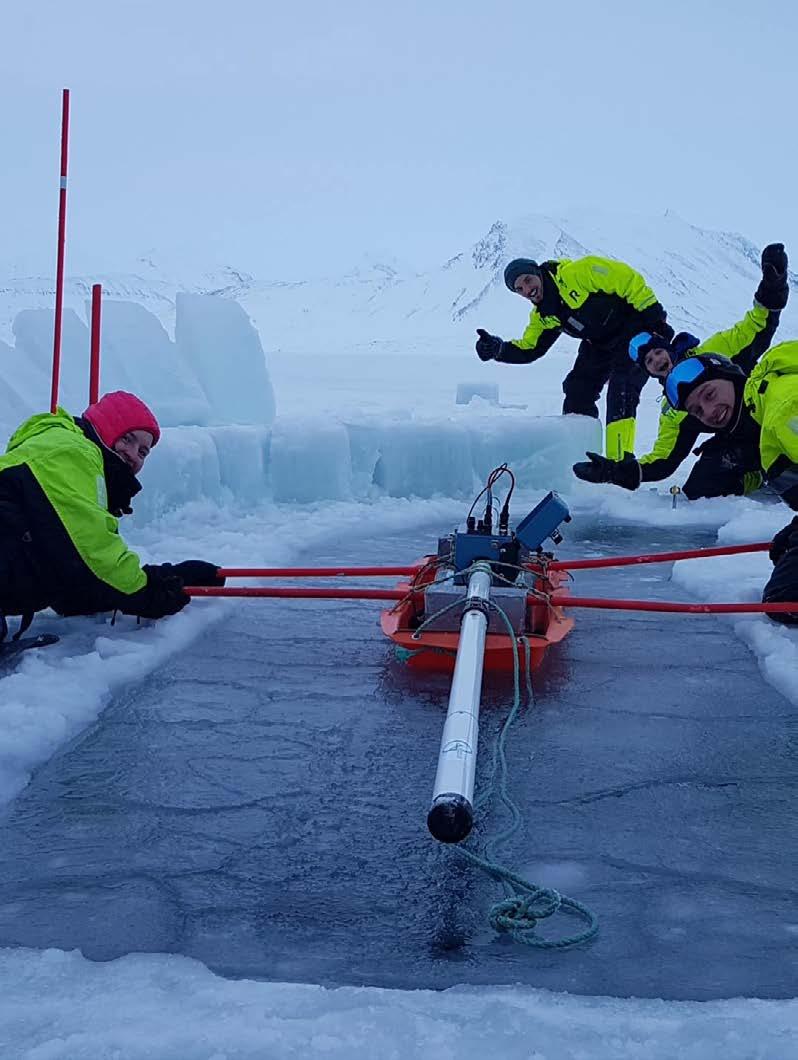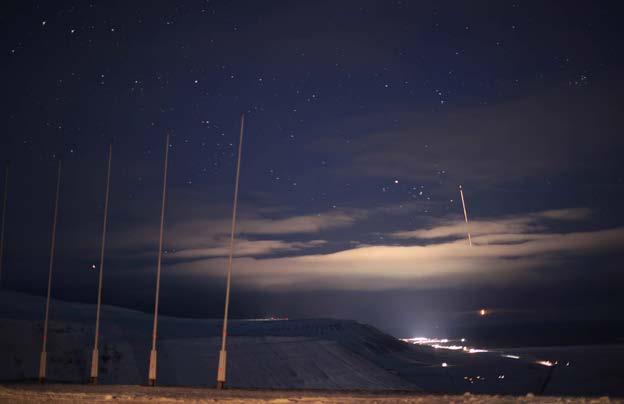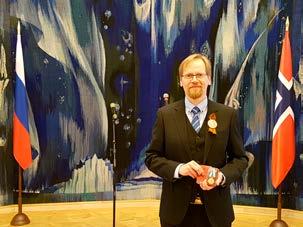
10 minute read
ARCTIC GEOPHYSICS
26 | ANNUAL REPORT 2019 ARCTIC
GEOPHYSICS
Advertisement
BY DAG A. LORENTZEN, HEAD OF DEPARTMENT
The Arctic Geophysics departments two research groups conducts research and education in the column from sub-sea to near space.
The department had at the end of 2019 eight full time faculty in the fields of oceanography, meteorology, and space physics. The department also had two post docs and one project research scientist, eleven adjuncts and six PhD’s. In addition, two engineers are working in the department.
EDUCATION Courses are offered in all the research fields within the department. In 2019, seven Bachelor courses and six Master/PhD courses were given. Some of the courses are combined into semester packages; the department offer one full semester bachelor package and one full semester master/PhD package during the spring term, and two full semester bachelor packages during the fall term. All courses include a field work component, either in a location out in the field, a research cruise or in a field station/observatory. In 2019, AGF-319/819 Shipping in the Arctic, was run as a master/PhD course for the first time. 11 students (6 master and 5 PhD) took the successful course. This course is an interdisciplinary course providing lectures on climate, sea ice, weather, environment, navigation, technology, infrastructure, economy, regulations, and geopolitics related to shipping in the Arctic.
RESEARCH
Space physics
The space physics group is part of the Birkeland Centre for Space Science – a centre of excellence in space physics which is based at the Univ. of Bergen. The space physics group operates two large scale research facilities, the Kjell Henriksen Observatory (KHO) and the SuperDARN radar. At KHO, the activity has been high in 2019 with several events. The observatory hosted two high profile visits by the Norwegian Minister of Education and Research and the US Ambassador to Norway. Preparations for the auroral season were hectic with painting, fixing water leaks from the domes and water supply maintenance. KHO is still attractive to the space science community with 24 external groups from 14 nations present. Our tracking system with 4 cameras is operational and tested successfully. Three rockets have been launched as part of the Grand Challenge Initiative (GCI) with vital ground-based support from KHO. Parts of the space physics group also provided ground support from EISCAT during the GCI campaign in November/ December 2019. The space physics group has also been working on the planning for rebuilding the antenna arrays of the SuperDARN radar that broke down due to heavy ice and wind loads in fall 2018, and this project is on track.
November 2019: The rocket ICI-5 (part of the Grand Challenge Initiative) was launched from Ny-Ålesund. This photo is taken on Breinosa outside Longyearbyen. Photo: Martin Langteigen/EISCAT.

The RCN PolarProg project (which is a collaborative project between scientists at UNIS and in Russia) was completed at the end of 2019. The project investigated modulations in ionospheric parameters (such as temperatures, densities and auroral brightness) caused by various coupling mechanisms such as that which occurs between the Earth’s magnetic field and Suns (the Interplanetary Magnetic field). Data from a variety of instruments across Svalbard (including the KHO) were used, along with supporting satellite datasets. The project was a great success with eight exchange visits, presentations at eight national and 20 international meetings, one dedicated session at the 2018 EGU meeting and 10 publications in international peer reviewed journals. An application has been submitted the Research Council of Norway’s INTPART call for funding to continue and extend the project to include more datasets and additional researchers.
The algorithm looking at flow channels across the polar cap has been successfully applied to one year of the Svalbard SuperDARN radar and detected over 500 events. The statistical study indicates a significant population of flow channel events associated with dayside reconnection processes which is the subject of ongoing work. Two case studies were examined in detail and, although the channels are considered mesoscale phenomena inside the ionospheric polar cap it was found they can account for 60% of the total cross polar cap potential (which is an indictor as to the strength of the overall convection inside the polar cap and can be thought of as a proxy for the coupling efficiency between the solar wind and geomagnetic field). The middle atmosphere team of the space physics group focuses on detection and characterization of particle precipitation, and studies of the effects of high-energy particle precipitation on the Earth’s atmosphere. In December 2019, Erkka Heino defended his PhD thesis on solar proton impact in the Earth’s atmosphere. The studies in the thesis clearly show that the current implementation of the solar proton impact area in the climate models is significantly overestimating the region where energetic solar protons can access the atmosphere. Due to their high energies, the protons cause strong ionization and consequently a large-scale depletion in the stratospheric ozone, which can last for several days. It is thus important to improve the description of the proton impact area for the future atmosphere and climate modelling efforts in order to more accurately estimate the natural climate variability. Another highlight of the year is that the new SuperDARN method to detect energetic particle precipitation with the sudden attenuation of received power and sky noise can not only be used to monitor solar protons but successfully detects energetic electrons as well. This will provide another important tool to improve the energetic particle forcing in the climate models.
Air-Cryosphere-Sea Interaction
The meteorology section has the co-lead on the four-year RCN funded project Advanced models and weather prediction in the Arctic: Enhanced capacity from observations and polar process representations (ALERTNESS). The main aim of the project is an improved weather prediction capability for the Arctic, benefiting amongst others increased high-latitude activities related


May 2019: An AGF-352/852 student analyse water samples onboard “Polarsyssel”. Photo: Marika Marnela/UNIS.

May 2019: AGF-352/852 students setting out a CTD onboard «Polarsyssel”. Photo: Marika Marnela/UNIS.

May 2019: The Russian Consul General in Barentsburg presented Professor Frank Nilsen and UNIS the Russian Ministry of Emergency Rescue medal "For good fellowship in the name of rescue". Frank Nilsen participated in the rescue operation following the tragic helicopter accident outside Heerodden in 2017. Photo: Fred Skancke Hansen/UNIS.
to e.g. shipping, fishery, transportation and tourism. The project centres on the AROME-Arctic weather model, that is operationally run for a region covering Svalbard, the Barents Sea and the northern parts of Fennoscandia. Research connected to the project has already yielded important results and lead to publications on for example verification metrics for weather models and ‘rain on snow events’ -events where precipitation falls as rain during winter.
UNIS and the Norwegian Meteorological Institute have signed a collaboration agreement. The meteorology team has had a central role in getting this agreement in place and one good example of ongoing work is collaboration on weather stations around Longyearbyen. The weather station by the old auroral station in Adventdalen is run in a joint effort between the two institutions and work is currently ongoing in installing a new weather station in Longyearbyen.
The oceanography team is deeply involved in the Nansen Legacy. The team’s main delivery into the project is to provide data sets from year-long moored instruments and process cruises around Svalbard, and to study the processes contributing to the ocean heat input into the region north of Svalbard and the northern Barents Sea. See more details in separate chapter.
New national marine infrastructure has been developed through the RCN funded SIOS project Svalbard Integrated Earth Observing System – Infrastructure development of the Norwegian node (SIOS-InfraNor). The interdisciplinary oceanographic mooring combining physics, biology, and chemistry, have been designed in collaboration with Aanderaa Data Instruments AS and will be deployed in Isfjorden with online data access as soon as possible in 2020. This mooring, together with a surface buoy, makes it possible to reveal some of the controlling forces and possible weather conditions for warm water intrusion into the Isfjorden system. Measurements of the water column in Isfjorden during winter and spring months are necessary to evaluate the potential danger for weak sea ice and melting sea ice due to warm water intrusion. Moreover, the interdisciplinary sensor design makes it possible to monitor e.g. the spring bloom development and possible energy extraction form surface gravity waves.
exchange flow between the shelf and fjord and are both part of the field work in the bachelor course AGF-214 Polar Ocean Climate. The southern mooring has delivered valuable data sets of hydrography and current since 2005 (with a few missing years). In September, this mooring was also equipped with a new instrument with biological sensors to further enhance the interdisciplinary collaboration with the biology department at UNIS. This collaboration has already resulted in published work in 2019 based on the Isfjorden-Adventfjorden time series station (IsA), where species composition was linked to season and presence of different water masses. The northern mooring was moved further inside Isfjorden on the southern side to follow any intrusion of warm and saline Atlantic Water (AW). In addition, standard hydrographic sections were obtained in April and September during the bachelor courses AGF-211 Air-Ice Sea Interaction I and AGF-214, which have been done almost regularly since 1999. During this time period Isfjorden has experienced a dramatic climatic change with less sea ice cover and more inflow of AW both in winter and summer. This collection of UNIS data is published in 2019 as a database called UNIS hydrographic database (UNIS HD) in the Norwegian Polar Institute’s data archive and is scientifically linked to a revised study of the variability and trends in the fjord’s climate and circulation. Additionally, all the yearlong mooring data obtained by UNIS from the Isfjorden system over the years were published in 2019 in the same data archive and are also linked to the same study. A related study of the Kongsfjorden hydrographic transect was published as a book chapter in 2019, where the used data were published as a subset of the UNIS HD (Kongsfjorden Transect CTD data 1906-2016) in the Norwegian Polar Institute’s data archive.
GRADUATES 2019
PHD DEGREE:
YLVA ERICSON
Drivers of the marine CO 2 system in the High Arctic - from the deep basins to the shallow fjords. (UNIS and University of Bergen).
The chemical oceanography team published work with emphasis on the marine carbon cycle and ocean acidification from data sampled in Isfjorden and Tempelfjorden between 2015 and 2017. The physical and biogeochemical processes that govern changes in total alkalinity (TA), total dissolved inorganic carbon (DIC), and the saturation state of the calcium carbonate mineral aragonite (Ω Ar ) were assessed on a monthly timescale. Primary production resulted in the largest changes that were observed in the partial pressure of CO 2 (pCO 2 , 140 µatm) and the saturation state of aragonite (Ω Ar , 0.9). Over the period of peak freshwater discharge (June to August), the freshwater addition and air-sea CO 2 uptake governed the surface pCO 2 .
MASTER DEGREE:
OLA BAKKE AASHAMAR
Heavy rain events in Svalbard summer and autumn of 2016 to 2018. (University of Oslo and UNIS).
JOSHUA DREYER
A detailed study of auroral fragments. (Uppsala University and UNIS).
FLORINE ENENGL
On the relationship between energetic electron precipitation and mesopause temperature. (KTH Royal Institute of Technology and UNIS).
ERKKA PETTERI HEINO
Spatial extent of solar proton impact in the Earth’s atmosphere - Observations and modelling. (UNIS and the Arctic University of Norway).
CHARLOTTE M. VAN HAZENDONK
Calibration of a Hyper Spectral Imager. (Eindhoven University of Technology and UNIS).
MARIE BØE HENRIKSEN
Hyperspectral Imager Calibration Characterisation and Image Correction. (NTNU and UNIS).
SARA GASPARINI
Statistical properties of backscatterfrom the Longyearbyen SuperDARN radar. (NTNU and UNIS).
ABEL PRUCHON
Analysis of the STeP (Storfjorden Polynya multidisciplinary study program) data. (Centrale Nantes and UNIS).










